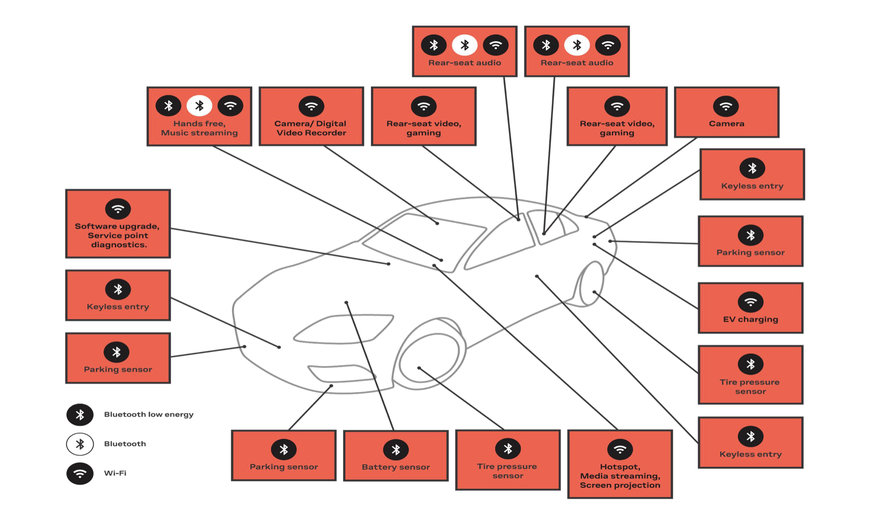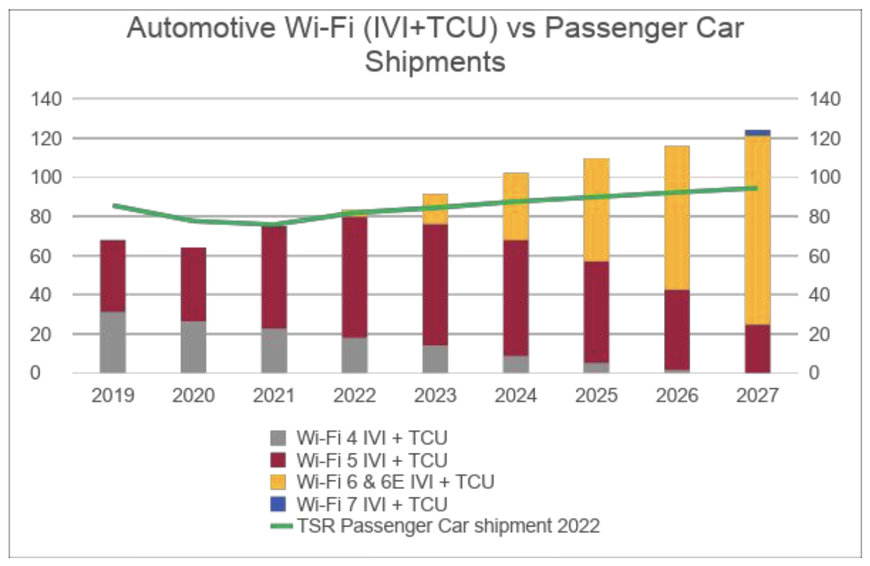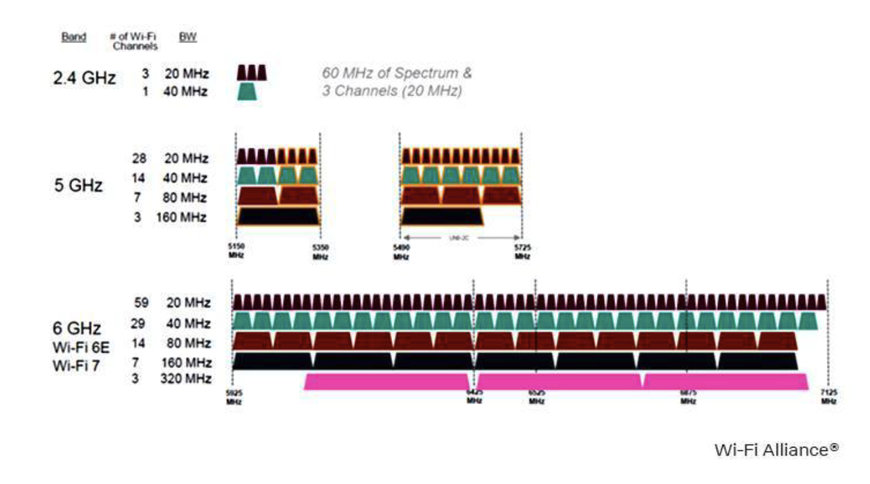Wi-Fi at the heart of the Connected Car
By Fredrik Lonegard, Product Marketing & Business Development Manager at u-blox.

On board applications demand wireless bandwidth
Modern automobiles increasingly resemble mobile Internet of Things (IoT) devices, using an array of sensors to improve driver safety and convenience by collecting and acting on internal and external data. Wireless communications are a fundamental enabler of this evolution in automotive technology, and the rapidly growing volumes of data generated by applications such as Advanced Driver Assistance Systems, (ADAS) and In-Vehicle Infotainment, (IVI), are driving innovation in wireless technologies such as Bluetooth, Wi-Fi and cellular.
Wi-Fi is well established in the automotive sector and has responded to the demands of the connected car with a focused set of releases, moving the technology from Wi-Fi 5 through Wi-Fi 6 and 6E, with Wi-Fi 7 in the pipeline, each offering enhancements in bandwidth, throughput, and efficiency. In this article we look at these developments in the automotive industry and the associated evolution of Wi-Fi before discussing how developers of automotive applications can maximize the benefits of the latest Wi-Fi releases.
The Era of the Connected Car
Sophisticated electronic devices are transforming the modern automobile, enhancing the safety, convenience and experience of the driver and passengers, while enabling the creation of a rich support ecosystem around the vehicle. In-Vehicle Infotainment, (IVI), systems are increasingly sophisticated, supporting audio and video-streaming functionality, and Advanced Driver Assistance Systems (ADAS) interpret data from a plethora of sensors within the vehicle.
Wireless communications are at the heart of this transformation, enabling not only the transport of data within the vehicle, but also the concept of the “Internet of Vehicles”, or the connected car. Connected cars are increasingly sharing data with their external environment, including other road users, intelligent roadside infrastructure, and pedestrians. By some estimates, autonomous vehicles will generate up 80 GB of data per driven hour, with a significant proportion transferred outside of the car, supporting remote diagnostics and predictive maintenance use cases.
This rapidly expanding number of connected automotive applications and use cases, figure 1, is driving an increased demand for wireless bandwidth and throughput.
IVI applications are data hungry, with Spotify alone using up to 150 megabytes per hour, while some estimations suggest that high-spec ADAS systems can gather as much as 1.4 terabytes every hour. At the same time, OEMs are shifting from traditional, transactional approaches to focus on monetizing their installed bases, through services such as OTA software and feature updates, and in-vehicle commerce applications. With the global connected car fleet projected to almost quadruple in size from 236 million units in 2021 to 863 million in 2035, the dependence on wireless data will only grow.
Connected automotive applications are currently heavily dependent upon Bluetooth® and Wi-Fi, but both technologies must evolve to avoid the risks of signal fading and degraded performance. The expanding mix of in-car applications, each with its own set of characteristics and system requirements, is putting higher demands on how the Wi-Fi system handles its resources and the 2.4 GHz band, shared by both Bluetooth® and Wi-Fi, is becoming over-crowded. Although the availability of the 5 GHz band has eased the situation, further measures, such as introducing the 6 GHz band as part of Wi-Fi 6E, are required to ease congestion and increase throughput.
The car wouldn’t be connected without Wi-Fi
Bluetooth and Wi-Fi are both well-established within the connected vehicle architecture, with cellular technologies including LTE and, increasingly, 5G supporting external connectivity. Although 5G promises significant enhancements in bandwidth, throughput and latencies, analysts predict that over 70% of future 5G traffic will be off-loaded to Wi-Fi, to minimize costs. In practice, multi-mode solutions will enable applications to switch between 5G and Wi-Fi, depending on the attractiveness, (coverage, speed, cost, etc.), of the respective network. In busy cities, for example, with many cars and high demand for data, 5G and Wi-Fi could run concurrently whereas in situations such as charging stations or parking lots, Wi-Fi alone will be able to support the required data rates.
Automotive applications have access to significant ongoing and planned evolutions of the Wi-Fi standard, which are set to bring increased levels of efficiency along with more wireless spectrum and throughput. These evolutions, coupled with the cost-effectiveness of unlicensed spectrum, will consolidate Wi-Fi’s central position in automotive architecture, and shipments of automotive Wi-Fi units are forecast to continue to grow, figure 2.

Forecast shipments of automotive Wi-Fi units.
Wi-Fi Responds to the Demands of the Connected Car
Since it first appeared in 2011, Wi-Fi has become a common feature in modern automobiles. While most currently come equipped with Wi-Fi 5, (802.11ac), automakers and OEMs are increasingly taking advantage of the enhanced features and capabilities of Wi-Fi 6 and Wi-Fi 6E, figure 3, in their devices to future proof their vehicles. According to Analysts ABI Research, 70% of the Wi-Fi chipsets shipped into automotive applications will be Wi-Fi 6 by 2024 with Wi-Fi 6E device shipments also growing rapidly and Wi-Fi 7 devices set to appear in 2027.

Successive Wi-Fi releases introduce additional features and capabilities.
Released in 2014, Wi-Fi 5 addressed the issue of congestion in the 2.4 GHz band by operating at the less congested 5 GHz frequency. Wi-Fi 5 introduced other techniques such as Multi-user MIMO, (Mu-MIMO) and OFDM modulation to improve spectral utilization and throughput. Although most connected cars currently utilize Wi-Fi 5 technology further releases bring significant enhancements, particularly to bandwidth and throughput-hungry applications operating in challenging, congested environments.
Wi-Fi 6 (802.11AX), released in 2019, utilizes several techniques to reduce congestion, support higher data rates and improve user experience, and offers up to four times higher spectral efficiency than Wi-Fi 5. Fundamental to this improved performance is Orthogonal frequency-division multiple access, (OFDMA), a high-order digital modulation scheme, which enables more users to communicate simultaneously.
Unlike Orthogonal Frequency Division Multiplexing, (OFDM), used in Wi-Fi 5, which transmitted fixed bandwidth data packets sequentially, OFDMA transmits variable sized data packets simultaneously using 256 subcarriers instead of 64. As illustrated in figure 4, OFDM dedicates one packet in a single stream for one device, whereas with OFDMA channel sharing, a packet can include information to multiple clients in multiple streams simultaneously.
OFDMA consequently improves device capacity in dense environments and reduces the impact of multi-path fading of the higher frequency carrier signals, increasing the robustness of Wi-Fi 6 in outdoor environments. Other key features of Wi-Fi 6 include:
- 1024-QAM modulation increases throughput by 25%, over the 256-QAM modulation scheme used by Wi-Fi 5, by enabling each symbol to carry 10 bits instead of 8.
- Multiuser multiple-in multiple-out, (MU-MIMO), is deployed in both the uplink and downlink in Wi-Fi 6, further increasing throughput and capacity in both directions.
- Target Wake Time, (TWT), reduces power consumption by allowing devices to negotiate when and how often they will wake up to send or receive data. TWT is valuable for applications which must run when the car is not in use, reducing the drain on battery charge.
- Single User Extended Range feature increases the time a symbol stays in the air from one microsecond to ten. Although this longer symbol transmission time reduces data rate, both the quality and reliability of the data transmission are improved, enhancing transmission over longer distances.

Wi-Fi 6 uses OFDMA to enhance spectral efficiency.
Following on from Wi-Fi 6, Wi-Fi 6E has rapidly been adopted by many countries since the FCC’s decision in 2020 to open the 6 GHz band. By utilizing the 6 GHz band, Wi-Fi 6E gives applications access to an additional up to 1200 MHz (depending on the country) of spectrum, allowing the migration of data traffic to higher frequencies, reducing pressure on the 2.4 GHz band. Wi-Fi 6E offers an up-to-fourfold increase in bandwidth capacity, with devices able to operate in 14 additional 80 MHz channels or 7 additional 160 MHz channels, figure 5.

Wi-Fi 6E opens up to use new spectrum in the 6GHz band.
The next evolution of the Wi-Fi standard will be IEEE 802.11 be – or Wi-Fi 7, which is scheduled to be released in 2024. Wi-Fi 7 will operate across the 2.4GHz, 5GHz and 6 GHz bands and will deliver extremely high throughput. This latest Wi-Fi standard will include the following functionality:
- A doubling of channel width over Wi-Fi 6, from 160MHz to 320MHz
- 4096-QAM modulation, enabling each symbol to carry 12 bits
- More efficient use of channel spectrum by enabling multiple resource units to be assigned to a single user
- Multi-link operation, enabling devices to simultaneously send and receive data across different frequency bands and channels – thereby increasing throughput, reducing latency, and improving reliability.
u-blox, Wi-Fi and the automotive sector
Wi-Fi technology is already well established in the automotive industry and the series of focused releases described above give developers of automotive applications such as IVI, ADAS, and telematics control units an upgrade path as modern automobiles generate increasing amounts of data. In this fast-moving environment, OEMs, and Tier 1s must choose the development path which will give the fastest time to market while optimizing cost.
As a global leader in automotive technology, u-blox has a positive track record of helping their customers succeed and the JODY series of modules continues this commitment, offering rapid and simplified development options for Wi-Fi, Bluetooth Classic and LE based applications in all their variants. The pre-certified modules and supporting development kits in the highly successful automotive, JODY portfolio are ideally suited to automotive telematics, and IVI applications.
The modules support a wide range of purposes, including Telematics Control Units (TCU), OTA updates, ECUs (Engine Control Units), as well as camera connection via Wi-Fi. The JODY portfolio offers multiple advantages to the developer, reducing development time, simplifying PCB and device design, and accelerating time to market, while reducing overall direct and indirect costs.
As automobile manufacturers use technology to differentiate their vehicles the connected car will continue to demand high performing wireless communications. Already well-established in the automotive sector, Wi-Fi offers a well-defined upgrade path to OEMs and Tier 1s and pre-certified modules such as those in the JODY portfolio from u-blox enable the developer to stay ahead of the market.
www.u-blox.com

